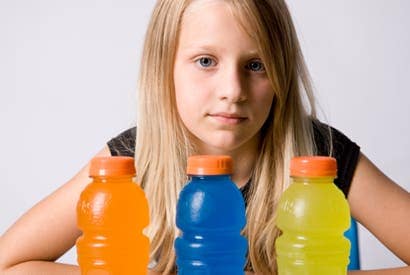
Many popular sports and energy drinks on the market are just as sugary as sodas, finds a new UC Berkeley report. (iStockphoto)
Disguised under a ‘health halo’, manufacturers selling energy and sports drinks advertise their products as being a healthy alternative to soda. A report filed by researchers at the Atkins Center for Weight and Health at UC Berkeley found that not only did most popular drinks contain just as much sugar as sodas, but the added list of confusing supplements provide little or no health benefits. Moreover, in some cases, these ingredients may actually be dangerous. Overall, the researchers conclude, most energy and sports drinks are nothing but sugary drinks with added supplements that unjustly label themselves as healthy.
Just a label that sells
[ALSO READ] Energy drinks mixed with alcohol makes you drink more
“Despite the positive connotation surrounding energy and sports drinks, these products are essentially sodas without the carbonation,” says lead author Dr. Patricia Crawford. “Rather than promote health as claimed in advertising, these drinks are putting our children’s health at risk.”
The researchers studied 21 popular beverages touted by producers as “health and strength enhancing”, one way or the other, and sought to understand what effects these might have on their target group: children and young adults.
The first startling finding was that these products contained significant quantities of sugar and calories, rivaling soda drink. Then, the researchers took notice of the many and confusing additives that are typically marketed as health and performance‐enhancing: caffeine, non‐caloric sweeteners, sodium, vitamins and minerals, and other supplements such as guarana, ginseng, taurine, gingko biloba and ginger extract. Of these, only ginger is classified as safe for children use by the National Institutes of Health, National Center for Complementary and Alternative Medicine.
Of great concern is the synergistic effects the added ingredients have with sugar in great quantity. An example would be caffeine’s increase physiological effect when it blends with guarana. Speaking of caffeine, the active ingredient is the reason why most manufacturers label their drinks as performance, endurance, and concentration enhancers. In reality, the opposite occurs increasing stress, nervousness, anxiety, headaches, insomnia, tremors, hallucinations, and seizures, while reducing academic performance. Talk about a rip-off!
What about the added vitamins and minerals typically found in sports and energy drinks? The researchers note that these vitamins are best supplied through the average diet and that consumers run the risk of exposing themselves to higher concentrations of certain vitamins and minerals than it is necessary, all the while gobbling a lot of liquid sugar.
In light of these findings, the researchers aren’t light on manufacturers.
“They are essentially sodas without the carbonation, but they give the misleading impression that they are healthy,” Crawford writes.
Crawford concludes: “The marketing of fortified beverages as beneficial or health‐enhancing is premature at best and deceptive at worst. The beverages discussed in this report contain ingredients that have not been shown to provide the benefits that are claimed for them, and many of which have not been proven safe for consumption by youth.”
The detailed report can be read at www.publichealthadvocacy.org/healthhalo.html









